THE COMPLETE PUBLISHER AD TECH STACK: EVERYTHING YOU NEED TO KNOW
Get a PDF copy of the guide using the form below, or scroll down to read the entire guide right on this page.
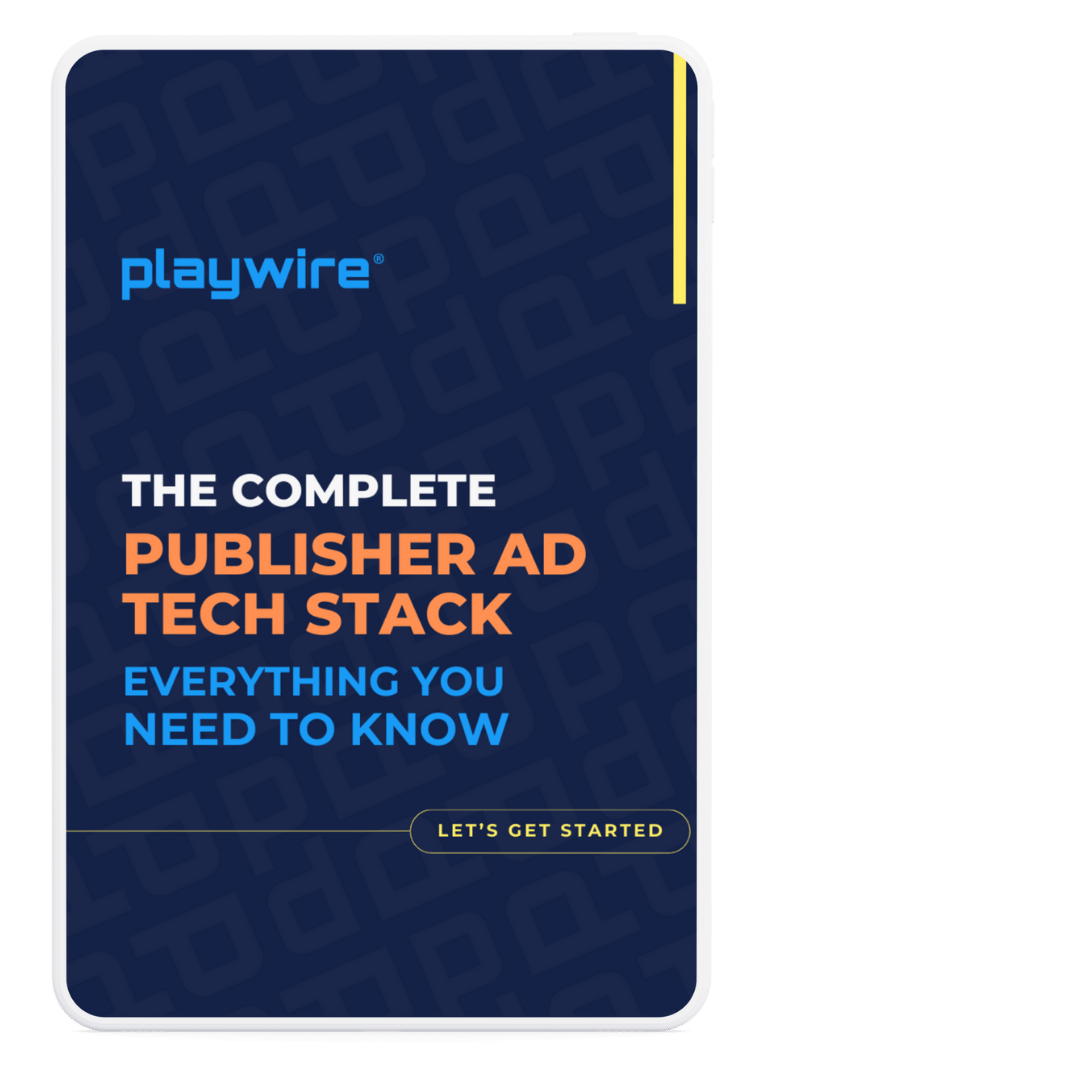
Don't Have Time To Read the Entire Guide Now?
We'll email you a downloadable PDF version of the guide and you can read later.
All of our content is generated by subject matter experts with years of ad tech experience and structured by writers and educators for ease of use and digestibility. Learn more about our rigorous interview, content production and review process here.
Built with the expertise of:
INTRODUCTION
- Your ad tech stack evolves as your audience grows.
- For both web and app publishers, the ad tech stack involves dozens of moving parts and considerations that can be difficult to manage.
- Reputable revenue management partners will only want to work with you once you reach a certain size.
- The right partner can manage it all for you and grow your revenue exponentially.
The publisher ad tech stack is complicated. And it’s getting more complicated every day. New concerns and innovations develop quickly, and with each, the tech stack grows larger.
Honestly, it’s not easy for most publishers to keep up. To start, you may struggle to even grasp all of the types of tools you need in your tech stack.
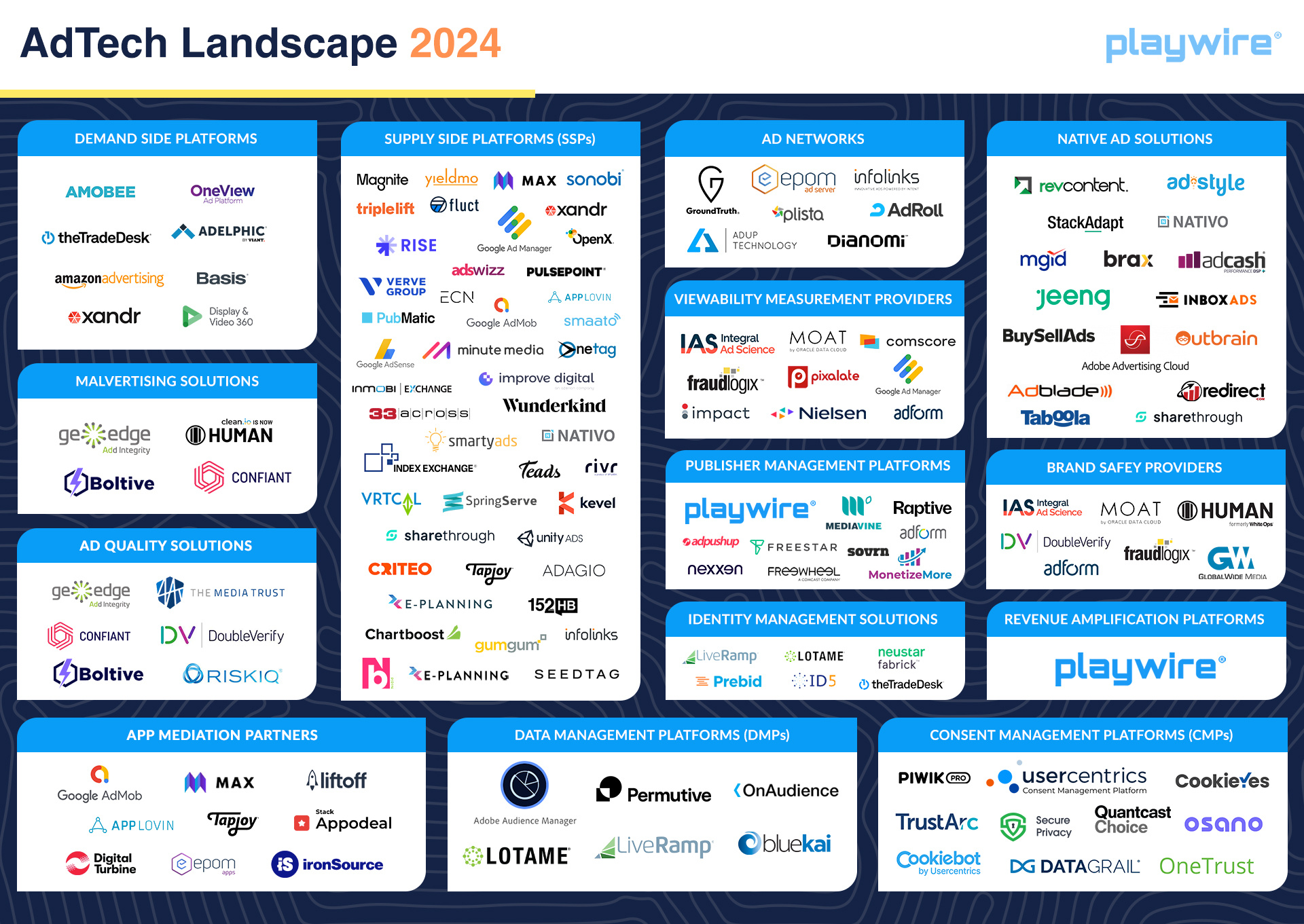
Even with a list of types of publisher ad tech tools in front of you, you may not know whether you’re at the level that actually requires each piece of advertising technology.
Then, of course, you have the age-old build vs. buy question: Should you buy a third-party solution for every piece of your tech stack, or should you build your own version of some or all of them? It’s another tough question — and one that depends yet again on your maturity level as a publisher and your budget and technical limitations. (Get the full build vs. buy rundown in our series on this topic.)
We’re going to sort all of this out for you today. The Playwire team has been steeped in ad tech from the very beginning, and we are ready to share what we know to make your life a whole lot simpler. Keep reading to get the complete picture of the modern publisher ad tech stack and how to put yours together.
Table of Contents
Your Ad Tech Stack Should Grow With You
.png)
Before we get too deep into the individual components of the publisher ad tech stack, let’s zoom out a bit and look at the evolution of the typical ad tech stack. If you are doing this right, you will slowly add pieces to your tech stack as you grow your audience. That’s how you do this sustainably.
Don’t be the person who has never been hiking before but drops 10 grand on gear before hitting their first hill. Be the person who picks the place they would like to hike and figures out which gear they’ll need to do it.
As you advance, your tech stack advances. If you’re a web publisher, you won’t need much more than a website and Google AdSense at the very beginning. You should always maintain focus on growing your audience, but the early stages are where audience growth is more important than anything else (even ad revenue). So, keep the ad tech stack uncomplicated at this stage and focus on your content.
.jpg?width=300&name=1_Beginner_Stack%20(1).jpg)
Stick with it, and your audience will grow. Once you’ve got a healthy-sized audience, you might begin to consider branching out a bit with your ad stack. Still, this may be as simple as going with Google Ad Manager — we’re nowhere near proprietary tech and direct sales at this stage.
.jpg?width=400&name=Beginner-Intermediate_Stack%20(1).jpg)
Once you can comfortably call yourself a medium-sized publisher or larger, you can start considering some of the more complex bits of the ad tech stack and your ad operations, such as header bidding solutions and consent management tools. With the addition of header bidding, you may graduate to a more dedicated ad server setup and a custom header bidding wrapper.
.jpg?width=400&name=Intermediate_Stack%20(2).jpg)
Reach a high enough level, and your users’ data starts to have its own substantial value. This is the final stage, when you begin to integrate data management tools to monetize your first-party data. This is also the stage in which you start bringing in a growing number of demand sources to drive your cost per mille (CPM) rates to new heights.
.jpg?width=400&name=Advanced_Stack%20(1).jpg)
When is an Ad Tech Partner the Right Move?
The publisher ad tech stack is an evolution — not a problem you solve overnight. That isn’t to say that there are no all-in-one solutions to the publisher ad tech stack. It simply means you have to reach a certain level before the reputable partners will find it worthwhile to work with you.
It’s a question of ROI on both sides. For example, Playwire wants to partner with mid-market or larger publishers because our RAMP platform starts to pay off enormously around that audience size. For smaller publishers, we find that the best bet is to keep growing your audience until you hit the size that’s appropriate for RAMP rather than getting bogged down in a bunch of unnecessary ad tech while you should be focused on your content.
Partnering with Playwire gets you access to the most comprehensive publisher ad tech stack ever built.
The Web Publisher Ad Tech Stack
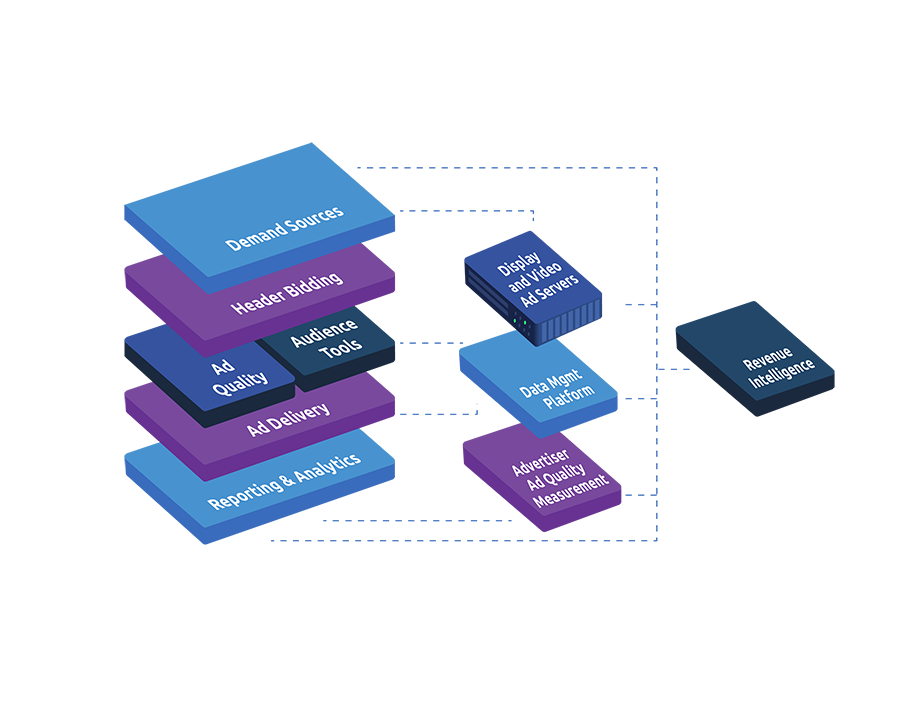
We’ll begin breaking down the tech stack for publishers by looking at each individual piece for web publishers first. Later, we’ll cover the ad stack for app publishers. Here are the pieces of the complete ad tech stack for web publishers:
.png?width=3500&name=Web-Ad-Tech-Stack%20(1).png)
Navigate straight to the piece of the ad tech stack you are interested:
- Header bidding
- Ad server
- Video player
- Brand safety and ad verification
- Consent management
- Identity resolution
- Online video platform
- Data management platform
- Beyond the Ad Tech Stack: Revenue Intelligence
Read on for more detail on each of these pieces of tech, including a general definition, how they work, when you need them, building vs. buying them and general costs.
Header Bidding
Header bidding is one of the biggest ad tech innovations of the past decade, and it’s particularly exciting for publishers because of its potential to increase your revenue by such a large percentage.
About Header Bidding
Header bidding is an alternative to the traditional programmatic advertising method known as the "waterfall" method. Instead of running down a list of bidders and accepting the first bid that exceeds the price floor — as is the case with waterfall auctions — a header bidding auction keeps bidders blind to each other’s bids and accepts the highest bid. It’s not hard to see how that could increase your revenue.
How Header Bidding Tools Work
When you start talking about header bidding as a piece of the publisher ad tech stack, you’re really talking about a few distinct pieces of ad tech. First, you have the technology itself, which is driven by a few lines of code in the header of your website. Then, you have the header bidding wrapper, which provides an interface with which you can manage your header bidding auction rules and demand partners.
As for header bidding tools, these are usually platforms from big demand sources like Google (Exchange Bidding and Open Bidding), Amazon (Unified Ad Marketplace and Transparent Ad Marketplace) and Prebid (an open-source community). These tools combine the distinct pieces of header bidding technology to allow you to more easily implement header bidding on your site.
When You Might Need It
You don’t need header bidding right out of the gate as a new publisher. First, focus on building a strong audience with great content. You won’t need to start thinking about header bidding until you’ve implemented something like Google Ad Manager and played around with a few different types of ad units.
If your ad revenue begins to level off but your audience is still strong, you may be ready to start shopping for header bidding solutions. Publishers usually find themselves needing to incorporate a header bidding solution around the time they hit 250K monthly pageviews.
Build One or Buy One?
The deal in header bidding, and programmatic advertising in general, is that the third parties throughout the ecosystem take a cut of each dollar that flows through. The more hands an ad flows through, the more cuts are taken from the publisher’s final payout. Because header bidding maximizes CPMs and taps into higher demand, most publishers accept that arrangement.
However, if you are a publisher with a fair amount of technical expertise and a high starting budget, you may be able to build a header bidding solution that cuts out at least a couple of the middlemen. Still, you won’t be able to eliminate all of the additional parties because you will still need to integrate at least a few supply-side platforms (SSPs) to actually gain access to programmatic demand.
Header Bidding Costs
You typically pay for header bidding by agreeing for various third parties to take a small percentage of each advertising dollar that flows through the system and reaches you. As for the tech, such as the header bidding wrapper, your options begin at $0 with options like the open-source Prebid wrapper.
Ad Serving
If you’re running ads on your website, you are using some sort of ad server. As your audience grows, the ad server you use should become an increasingly important consideration as part of your ad tech stack.
About Ad Servers
Ad servers are the technology that actually puts ads in front of website visitors’ eyes. There are plenty to choose from, but this space is dominated by — who else — Google. Google Ad Manager (GAM) comes with ad serving capabilities, so most publishers go with that because the majority of publishers will already be working with GAM or AdSense to gain access to Google demand.
How Ad Servers Work
Ad servers do a few things. First, they actually house ad creative. When an auction is complete, they then “serve” that creative to the correct publisher’s website, as well as the correct ad slot on that publisher’s website.
Additionally, ad servers work as decision engines, meaning they choose particular ads to serve to particular users based on countless incoming factors, and they do it in a fraction of a second. Finally, ad servers collect and synthesize millions of data points on things like video completion rate, ad impressions, clicks, and many other metrics.
When You Need an Ad Server
If you’re doing any kind of digital advertising, you need and already use an ad server. If you grow into a particularly large publisher, you may need to begin exploring options besides the out-of-the-box solutions from well-known platforms, but that is a long way off for the vast majority of publishers.
Build One or Buy One?
Building an ad server is out of the question for almost all publishers. Except for maybe the largest publishers in the world, it’s simply not feasible from a cost perspective or, really, a technical perspective. Creating a functional server is a huge technical lift that requires a whole team of developers and engineers, as well as years and millions in initial investment.
The better question may be this: Should you implement and oversee the server you choose yourself, or should you work with someone who will do that for you? For a detailed breakdown of this issue, see the ad server entry in our Ad Tech Build vs. Buy Series.
Ad Server Costs
The cost of an ad server can vary widely. That’s because you have open-source and free options like Revive Adserver on one side, GAM and its baked-in ad server in the middle, and costly but perhaps more powerful options on the other side.
Video Player
In the 2020s, no publisher is going to maximize their revenue and not do video ads. Video is everywhere, and video ad CPMs are hard to ignore. But if you want to do video advertising on your website, you’re going to have to have some kind of video player.
About Video Players for Publishers
A video player is not the same thing as a video platform. The video player is simply the box that delivers video content and video ads to your website visitors. You may not think about them often, but video players are familiar to you — they’re square or rectangular and come with simple controls like play and pause along the bottom.
How Video Players Work
We won’t get too far into the specifics of how videos are delivered across the internet, but video players basically receive data that constitute a piece of video content and render them into a viewable video for the end user.
For publishers who want to run video ads, that’s only the first part of the puzzle. That’s because the video player needs to also be able to run video ads and receive the winning bids of the video header bidding process. Many ad tech tools and platforms will include video players that are capable of doing the basics of video content and ads.
When You Might Need a Video Player
If you have video content, intend to run video ads or both, you’re going to need a video player. It’s the only way you will be able to show video content or video ads on your website.
Build a Player or Buy One?
It is possible to build your own video player from scratch, but it’s hard to imagine why a publisher would want to do that when three easier options exist:
- Modify an open-source video player to meet your needs
- License an existing video player for a monthly, annual or one-time fee
- Work with a comprehensive video advertising partner who provides a pre-built video player
To get more details on whether building or buying a video player is right for you, check out our video player entry in the Ad Tech Build vs. Buy Series.
Video Player Costs
If you already employ a capable developer, modifying an open-source video player may not cost you too much. Similarly, if you’re working with a video advertising partner who provides their own video player, you can probably get your video player for free. Meanwhile, licensing a pre-existing video player could cost anywhere from hundreds to thousands of dollars per month.
Brand Safety and Ad Verification Solution
The advent of the internet lowered the barrier to entry to becoming a publisher. Suddenly, everyone who had the gumption to create a website could call themselves a publisher and start trying to bring in some ad revenue. That created a problem for advertisers, who not only wanted to make sure that their ads were shown alongside appropriate content but that their ads were actually being seen by the right audiences.
That problem called for a solution, which came in the form of brand safety and ad verification tools.
About Ad Verification and Brand Safety
Fraud and bad-for-brand content are rampant around the internet. And advertisers with any sort of meaningful advertising budget want some guarantees. Ad tech folks have risen to that desire by creating tools that work to ensure that ads are running alongside brand-safe content and that they are being seen by real people — not bots or otherwise fraudulent traffic.
How Brand Safety and Ad Verification Tools Work
Brand safety and ad verification tools work in two basic ways: automatically and with manual review. The automated bit is about getting easy wins. Ad fraudsters and complex content situations routinely create scenarios that automated solutions simply cannot spot or address, but these automated tools can prevent your run-of-the-mill brand safety and traffic fraud problems.
To prevent all brand safety issues, you will more than likely need a solution that includes a manual team. For example, you may need a real, live person to make sure you’re not on any ad agencies' block lists that are preventing programmatic revenue from flowing to your site. A bot can’t do that, but a person can.
When You Might Need Them
When you reach the stage in your digital advertising efforts at which you are trying to attract bigger buyers and direct buys, you need to consider a brand safety and ad verification solution. These tools will be a key part of the package you’re offering to those higher-value advertisers.
Build or Buy?
Unless you have a huge team of engineers and developers, you aren’t going to build your own brand safety and ad verification tool. However, you might piece one together with various third-party tools.
That’s because most of the existing automated tools are good at maybe one thing — preventing a particular brand safety problem or ruling out a particular type of fraud — but not everything. To get a comprehensive solution, you’re left to either piece together several or work with an end-to-end partner who manages every aspect for you.
Associated Costs
Unlike some of the other pieces of the publisher ad tech stack, which take small fees, have a free version or just take a cut of the money they make for you, brand safety and ad verification solutions can get pretty expensive — especially when you start using two or three to make sure you’re fully covered. Sometimes, the best bet from a budget perspective is to work with a revenue partner who handles these issues as part of their overall offering.
Consent Management
Whether it’s the General Data Protection Regulation (GDPR), the California Consumer Privacy Act (CCPA) or a similar law that applies to another part of the world, publishers around the globe have to comply with various online privacy and tracking laws.
Here’s the problem: This is a relatively new area of the law, and it is developing at break-neck speed and in different ways in dozens of countries simultaneously. Try to keep up with it all on your own, and you’ll get dizzy fast. That’s why the consent management platform (CMP) has become an essential part of the publisher ad tech stack.
About Consent Management Platforms
Good CMPs keep up with privacy and tracking consent laws and implement their requirements on your website. You can usually customize certain parts, such as the look and feel of your tracking opt-in messaging, but the way the platforms work is relatively stiff because they’re designed to keep you out of trouble.
These things are popping up everywhere because entrepreneurial ad tech professionals are seeing the need for help with consent management skyrocket — in other words, they’re seeing a business opportunity. That means this is sort of the Wild West for publishers. You want to make sure you’re picking the right CMP — one that will keep you in compliance and encourage tracking opt-ins to the highest degree possible.
How CMPs Work
CMPs can do a lot of different things, but the most basic function is one we have all seen hundreds of times before. It’s that little banner or window that pops up when you visit a website that says the website uses cookies and allows you to accept or reject them.
As a publisher, you know how important it is that as many users as possible accept the cookies. That’s how you create first-party data segments that lead to high-value audience segments to sell to advertisers. So, high-quality CMPs also work to encourage cookie opt-ins through design, messaging and other factors.
When You Might Need a CMP
If you’re currently using cookies of any kind on your site and you have users in an area that has a relevant internet privacy law — that’s now a major part of the world, by the way — you could probably use a CMP. This is how you prevent costly privacy lawsuits or other legal actions.
Build a CMP or Buy One?
You can build your own CMP, buy a third-party CMP or work with a revenue partner who manages consent and tracking for you as part of their overall offering. Due to high costs and heavy technical requirements, building a CMP is best reserved for huge publishers with highly specific consent management needs. Buying a third-party CMP is typically fine, but it can be expensive, and you may not know whether the tool is actually keeping you compliant.
Working with a revenue partner who offers consent management as a complementary service is often the best bet because you spend less overall and have a degree of accountability — someone to speak with when you’re concerned about a new privacy law or ask questions of when you run into a consent or privacy issue.
CMP Costs
CMPs run the gamut in terms of costs, depending heavily on what you need them to do. Free WordPress plugins will run cookie banners on your site, and third-party tools that cost thousands per month will use AI to optimize for cookie opt-ins. Where you fall on that spectrum will depend heavily on your size as a publisher.
Identity Solution
There was a time in ad tech when it seemed like the third-party cookie was always going to be around. That time is not now. In fact, the third-party cookie has experienced a swift decline after Google’s announcement that it was going to retire it completely.
Publishers immediately understand the problem the death of the third-party cookie will create. You lose the data about your users’ internet behaviors that you have relied on to deliver targeted ads and content, and that means your revenue is at risk. Fortunately, plenty of identity solutions have begun to pop up, and some of them are showing a lot of promise.
About Identity Solutions for Publishers
With any major change in the ad tech landscape, you typically see a bunch of companies and platforms form around the change in an effort to capitalize on it. The identity solution crisis has been no different.
Unfortunately, this creates a problem: These companies are popping up in a rapidly changing field, and they propose various solutions — all of which won’t survive the test of time. That means publishers may choose a particular identity solution and find that they have hitched their carts to the wrong horse soon after.
How Identity Resolution Tools Work
Most identity solutions revolve around leveraging first-party data rather than third-party data. They compile first-party data from a network of publishers or other sources to piece together what third-party data used to provide: audience segments that are of value to advertisers.
When You Might Need One
If you currently rely on third-party cookies of any kind to gather data on users, and if that data informs audience segments and other strategies to increase your CPMs, you need to consider an identity solution before Google finally kills the third-party cookie once and for all.
Build or Buy?
All but maybe a handful of publishers are too small to build their own effective identity solution that relies on first-party data. You might, however, be able to integrate several of these tools that work in different ways to keep yourself as covered as possible. However, this can lead to technical issues, overlap and high costs.
The alternative is to buy an identity solution that is built on principles that are likely to last well beyond the death of the third-party cookie, such as identity solutions built on massive (and growing) first-party data banks.
Associated Costs
Many identity solutions currently on the market are new, and their costs can vary widely. Some are trying to encourage adoption with low initial costs that will likely rise later. Others are charging more out of the gate to show their elite status. By far, your most expensive option will be integrating several identity solutions in an effort to choose one that will survive the coming shift in the cookie landscape.
Online Video Platform
Having a video player is step one to getting the premium CPMs that come with video ads. Step two — arguably the most important step — is having an online video platform (OVP).
About OVPs for Publishers
An OVP enables you to upload, monetize and manage your video content and hook into video header bidding ecosystems. Many OVPs will come with their own video player, and others may even provide some video content for you to run on your site and monetize with ads.
How Online Video Platforms Work
Online video platforms basically create an interface with which you can manage your video content and ads. They allow you to upload or create video content, monetize it with ads and run it on your site. They also come with the ability to connect with programmatic advertising setups to allow you to run video header bidding on your site.
Premium OVPs sometimes provide vertical-specific content for you to monetize, which is meant to reduce the cost associated with creating your own video content.
When You Might Need an OVP
If you would like to run video advertising of some kind on your website, you will need at least a basic OVP. If you’re running simple videos with in-stream ads in an embedded video player, you don’t necessarily need to go all in on an OVP with all the bells and whistles. That can come later, as your audience grows and you want to offer more interesting ad units, such as skinned videos and interactive pre-roll.
Build One or Buy One?
Building a video platform of any kind is going to require a lot of technical knowledge and skill, as well as a significant investment of time and money. This is one of those pieces of the publisher ad stack that really doesn’t need to be built again — there are plenty of OVPs out there at a range of prices and capabilities.
Video Platform Costs
OVPs can range from the free or nearly free to the prohibitively expensive, and that all depends on what you need them to be able to do. Assess your maturity as a publisher, as well as your current audience and video advertising needs, to make your choice.
Data Management Platform
Ad tech and big data are the peanut butter and jelly of the digital advertising world. They exist separately from each other, but they work best when they’re put together. That’s what data management platforms (DMPs) do.
About DMPs
DMPs are massive repositories of data about internet users. They may contain first-, second- or third-party data, although few still rely much on third-party data since Google’s announcement that it would kill the third-party cookie.
DMPs solve the problem of managing massive amounts of data. For publishers, managing just your own users’ data in a way that can boost your revenue is a challenge. And combining your data with other data from other publishers makes it much more effective and valuable. DMPs make that not just possible, but much easier by putting everything into a single user interface that lets you drill down and create effective audience segments.
How DMPs Work
The primary function of a DMP is to compile data, but they also offer a management function, in which publishers can view data in helpful ways, sort it by relevant factors and synthesize it into high-value audience segments to boost their CPMs.
The best DMPs on the market offer AI-driven insights, additional data from sources other than your own user base, automated reporting and data forecasting.
When You Might Need a DMP
When you have graduated from the early stage of just trying to bring in a little ad revenue and have truly started optimizing your revenue strategy, a DMP will begin to become useful to you. That means you need to be at least a mid-sized publisher, if not larger, before you go all-in on a DMP.
Build a DMP or Buy One?
DMPs are so massive and complex that entire companies offer a DMP as their sole product. It’s that much to manage. In other words, you probably don’t want to build your own. And you probably can’t.
But that’s OK. You can buy one that is both cost-effective and plain old effective. As you make your choice of DMP, look for the following factors:
- A real, demonstrated plan to handle the death of the third-party cookie
- Access to sources of data that go beyond just your site or sites
With those two factors taken care of, you should be able to create effective audience segments and drive your CPMs higher.
DMP Costs
DMP costs vary widely. If all you need is a platform to organize your data, you can get away with fairly low monthly costs, but if you need AI and other deep features, the DMP is likely going to cost you. One cost-effective alternative is to choose a comprehensive revenue partner that provides access to their proprietary DMP as part of the package.
The Mobile App Ad Tech Stack
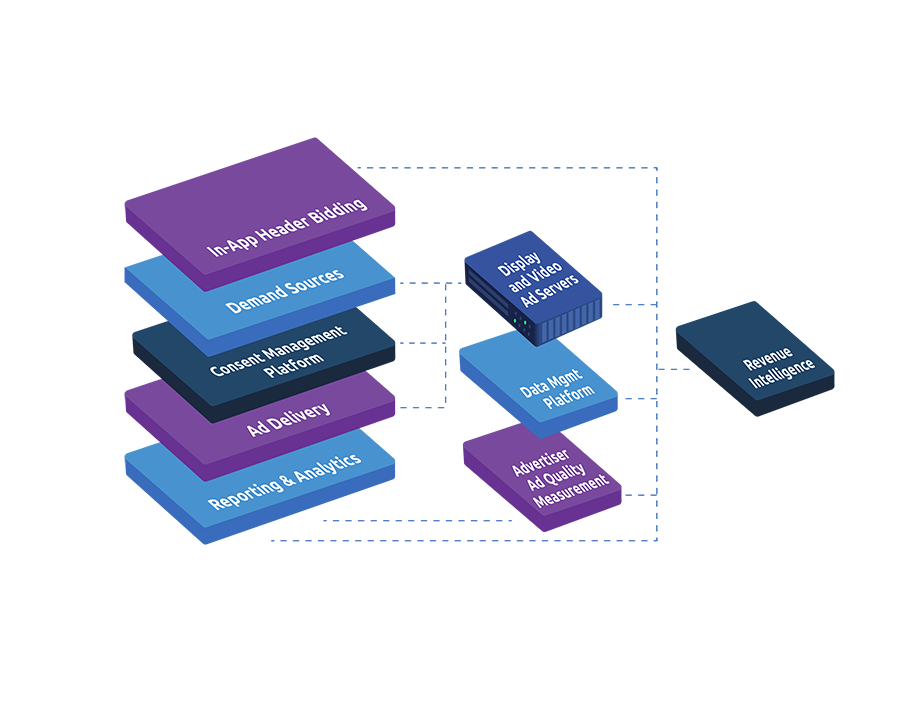
Outsiders might assume that the mobile app ad tech stack would by definition be more complicated than the ad tech stack for web publishers, but thanks to capabilities of high-quality software development kits (SDKs), app tech stacks are actually quite simplified in terms of the number of distinct pieces of tech you will need to consider integrating.
The typical ad tech stack for an app publisher will consist of the following:
.png?width=500&height=466&name=App-Ad-Tech-Stack%20(1).png)
Navigate straight to the piece of the app ad tech stack you are interested:
Here’s more detail on each of those pieces of the app ad tech puzzle.
In-App Header Bidding
Header bidding started with websites, but it didn’t take long for the ad tech world to see the potential of header bidding for apps.
About In-App Header Bidding
In-app header bidding is built into most comprehensive SDKs these days, and for good reason: This is how you get premium CPMs out of your in-app advertising strategy. Header bidding for apps rewrites the traditional programmatic auction process in the same way header bidding for websites does. All bidders make a blind bid, and the highest bid is chosen — not the first acceptable bid.
How In-App Header Bidding Tools Work
In-app header bidding tools work in a highly similar way to header bidders for websites. They send out a call for bids on every impression, select the best bid and serve the relevant creative to the user in a fraction of a second. The key difference is that, instead of a header bidding wrapper initiating the process, the process begins and ends inside your app’s SDK.
When You Might Need It
You don’t need to start thinking too hard about in-app header bidding until you have built both a great app and a decently sized (and growing) audience. Small publishers may end up spending more in time, money and headaches on in-app header bidding than they stand to make on it, and their time is probably better spent on improving the app and growing the audience. Medium and large publishers, however, can benefit enormously from in-app header bidding.
Build or Buy?
In some ways, you always “build” header bidding solutions for both apps and websites because you choose your sources of demand and integrate their SDKs into your SDK. The question is really whether you want to or can do all of that on your own. Revenue management partners will often handle all aspects of in-app header bidding for you, meaning you can focus on your app while your revenue grows.
In-App Header Bidding Costs
If you implement in-app header bidding at the right time in your evolution as a publisher, it should make you money in the aggregate. Still, you will lose a portion of each advertising dollar headed your way to the SSPs and other middlemen who take a cut. You also have to consider the cost of the initial technology, which can range from completely free to exorbitant.
Ad Serving for Apps
Ad servers are just as important for mobile app advertising as they are for web advertising. If you plan to run ads of any kind in your app, an app ad server is going to be a key part of your publisher ad tech stack.
How Ad Servers for Apps Work
App ad servers work in much the same way as other ad servers. They store ad creative and place it in front of users when prompted to. They also collect data on metrics like video completion rate, viewability and more. These servers exist as a link in the programmatic chain, so that when an auction is completed, they get the right message and select the right ad for the right ad slot.
When You Might Need One
If you’re running in-app advertising of any kind, you’re already using an ad server for your app. For most small publishers, the built-in varieties that come with platforms like Google’s AdMob work just fine. You won’t need to start thinking about a more advanced or dedicated server until your needs become much more sophisticated and your audience becomes much larger.
Build One or Buy One?
Building an ad server of any kind is simply not worth the cost and effort in the vast majority of cases. There are plenty of perfectly acceptable app ad servers that work for publishers of all sizes and all situations, so you’re likely going to want to go with “buy” on this one.
Mobile Ad Server Costs
The cost of ad servers for apps is usually rolled in with the cost of an entire tool dedicated to mobile app advertising — you rarely get a flat fee for the simple use of a server. Consider what else you’re getting alongside the server as you make your choice.
Consent Management
Consent management is one of the most pressing subjects for app publishers today. That’s because governments are changing or adding privacy laws left and right, and major companies like Apple are changing their policies. This can leave publishers caught in a delicate balancing act between their app revenue and their concern about getting into legal trouble.
About Consent Management for Apps
Just like consent management platforms (CMPs) for web publishers are popping up left and right for web publishers, app CMPs are everywhere all of the sudden. These tools inform app users that the app would like to track their behavior across other apps, and users can opt in or out.
How App CMPs Work
The basic function of an app CMP is to make sure your app remains in compliance with relevant privacy laws. Typically, this is as simple as providing a way for users to opt out of tracking via a banner message that pops up when the app loads.
But it can get much more complicated than that, especially when you consider how important it is to your app’s revenue that you convince a lot of your users to opt into tracking. Some of the more advanced app CMPs optimize for opt-ins with customizable messaging, smart design and various other strategies.
When You Might Need One
You probably need a mobile app CMP. If you have an app that is available to users on iOS, in Europe, in California, in Brazil or in a growing number of places around the world, you run the risk of running afoul of the law if you don’t have a high-quality CMP in place.
Build One or Buy One?
Building your own CMP is going to be a difficult technical task that will break even the sturdiest budget. You are more than likely going to need to buy a CMP, and the good news is that there are so many CMPs that you can easily find one that only provides what you need and nothing more.
Mobile App CMP Costs
CMPs for apps can vary widely in terms of pricing, but most are fairly budget-friendly. Just be sure you aren’t a small or medium publisher paying for premium CMP features meant for enterprise publishers, and your costs should remain relatively reasonable.
Putting the Entire Ad Tech Stack Together
As we have mentioned a few times here, you don’t have to — and really shouldn’t — implement each of these pieces of the ad tech stack all at once. Which pieces you build or buy and when you do so will depend heavily on the size of your audience. The end goal, however, is to grow so large that you ultimately need every piece of ad tech described here.
Managing that growth and understanding the optimal time to expand the tech stack is a headache. And even if you buck up, pop acetaminophen, and manage it well, you’re still left with the long-term headache of overseeing a dozen or more disparate tools, each with its own interfaces, tools, bugs, and requirements. Integrating them in any cohesive way is the ultimate challenge — and not in the fun “running a marathon” kind of way.
This challenge is the precise reason why so many publishers eventually partner with a revenue management platform that blends some or all of the pieces of the publisher ad tech stack into a single platform. The ones that truly do that and do it well are rare, but Playwire is one of them. And if you’re a medium to large publisher who wants to see your revenue grow, we’re interested in working with you.
Playwire: The Comprehensive Publisher Tech Stack Solution
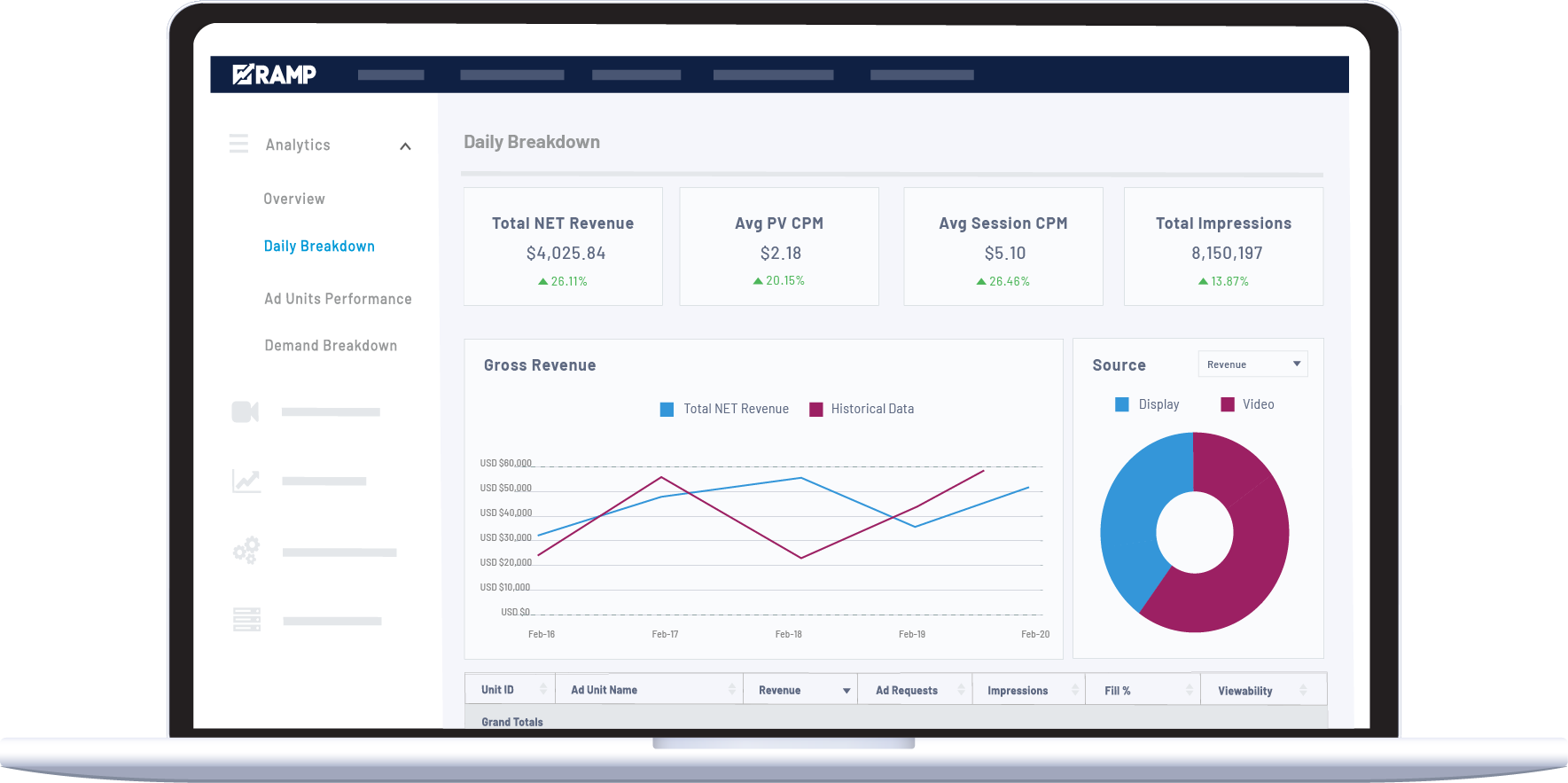
We’re not an ad tech multi-tool. We’re an ad tech platform — one that is managed by real (and real smart) people and driven by proprietary tech that consistently drives publishers’ revenue to previously unseen heights.
We make the publisher ad tech stack easy because we do it for you. It’s all integrated into our platform so you don’t have to think about it any more than you want or have time to. Like so many of the best things in life and business, it’s simple and effective. Seriously.
Whether you’re interested or have questions, we’re just a quick email away. Reach out to us today!

Related Content
You can visit the publisher ad tech stack resource center or dive deeper into any of these related articles:
- What is Ad Tech? A Basic Introduction to Advertising Technology
- The Evolution of the Publisher Ad Tech Stack
- The Ad Tech Stack: Should You Build or Buy?
- Ad Tech Stack Build vs. Buy Series: Brand Safety and Ad Verification Solutions
- Ad Tech Stack Build vs. Buy Series: Ad Serving
- Ad Tech Stack Build vs. Buy Series: Identity Solutions
- Ad Tech Stack Build vs. Buy Series: Ad Quality & Malvertising Solutions
- Ad Tech Stack Build vs. Buy Series: Data Management Platform
- Ad Tech Stack Build vs. Buy Series: Ad Monetization Solutions
- Ad Tech Stack Build vs. Buy Series: Consent Management Platform
- The Ad Tech Industry is Failing Publishers
AMPLIFY YOUR AD REVENUE
Accelerate your business and uncomplicate your ad tech stack, because you deserve a partner and a platform that demands more for you.



